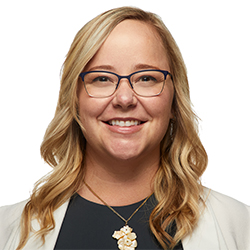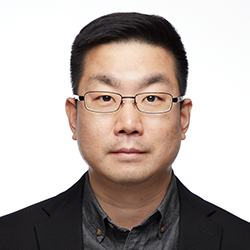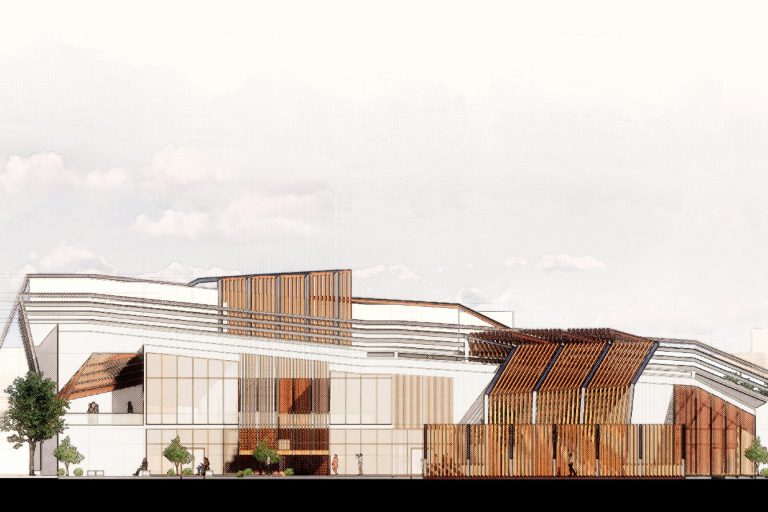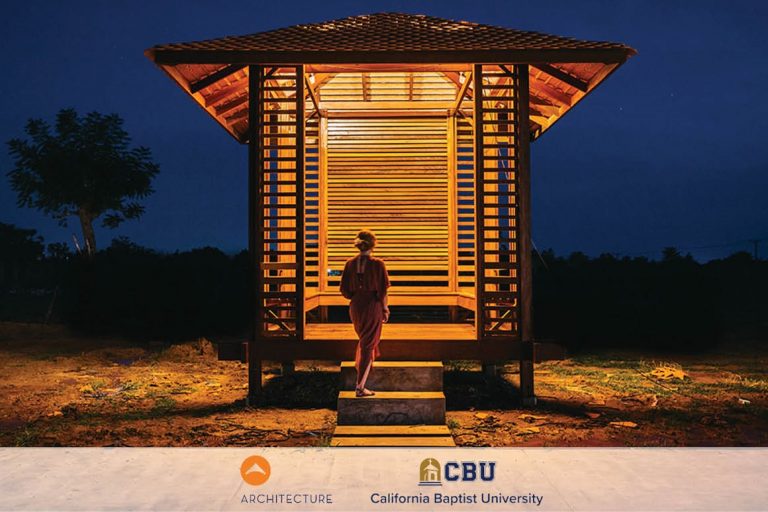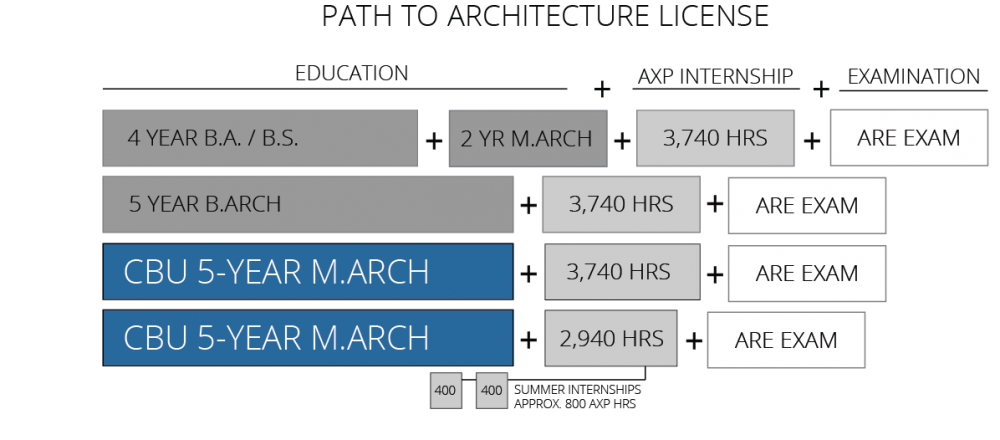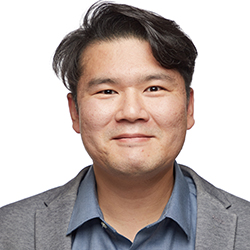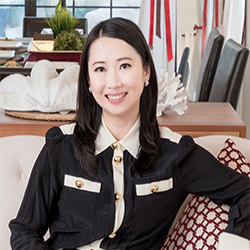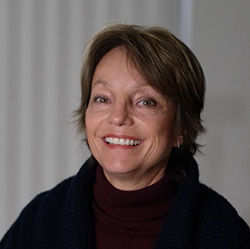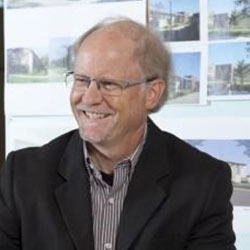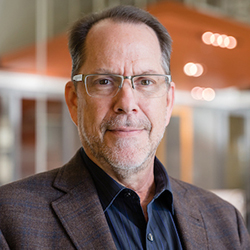
Architecture
Architecture
Know How, Know Why
The Architecture major creates a rich academic environment marked by the confluence of advanced practice, contemporary theory, and social engagement. Our primary goal is to help students develop the capacity and judgment necessary to understand the built environment and generate architecture as a critical response, so that each student can engage both the discipline of architecture and the multiple discourses – artistic, technological, social, political, environmental, economic, spiritual – necessary to be a successful practitioner and a conscientious citizen with a Biblical worldview.
CBU Architecture offers two degrees: Pre-professional 4 year Bachelors of Architecture, a fully accredited professional Master of Architecture degree. See Accreditation tab for further information on M.Arch degree accreditation.
Optional Graduate Architectural Concentrations
CBU Architecture offers four optional concentrations, allowing students to specialize and distinguish themselves as architects who demonstrate professional excellence and personal integrity, are servant leaders in their communities and who live biblically-based, missional lives within the profession.
At CBU Architecture, I have found a community of seekers; individuals who love to think deeply and reflect on the purpose of everything we do. We truly want to use our talents in architecture to serve our community and place people at the center of the built environment. — Josh Greene, Senior
News
Ready to See Differently?
B.A. Architecture
The Bachelor of Arts in Architecture at CBU is intended as a degree that will allow a student to proceed onto graduate studies, or into the workforce, in architecture or another discipline. It is not designed to be an accredited, professional degree and therefore does not satisfy the qualifications for licensure as an architect in most states in the U.S
General Education Courses
The general education requirements will follow the curriculum set forth for other university programs. Some general education requirements will be met through specific architecture major requirements.
Lower Division Requirements
ARC 120 Design Communications
Units: 3. Offered: Fall.
The course will establish a base of design concepts and knowledge with an introduction to references and ideas to foster independent inquiry. The course will develop foundational appreciation and skills for effective two dimensional visual expression through graphic representation.
ARC 122 Design Communications
Units: 6. Offered: Spring.
The course will establish a base of design concepts and knowledge with an introduction to references and ideas to foster independent inquiry. The course will develop foundational appreciation and skills for effective three-dimensional (3D) visual expression through graphic representation. Prerequisite: ARC 120. Pre- or Co- Requisite: DES 110.
ARC 210 Design Studio I
Units: 6. Offered: Fall.
The studio explores and develops conceptual strategies for basic formal and spatial design, emphasizing the role of ordering principles and of fundamental architectonic elements in the implementation of design intentions. Students also will be introduced to foundational processes for developing design projects through the application of formal analytical vocabulary, diagramming, drawing methods and conventions, and three-dimensional modeling. Prerequisite: ARC 122.
ARC 212 Design Studio II
Units: 6. Offered: Spring.
The studio focuses on conceptualization and implementation of architectural ideas in response to environment, landscape, site and enclosure, as applied to a specific program and building type. Students will continue to develop the foundational design processes introduced in previous studios, and will be introduced to the role of rigorous precedent analysis in the generation of architectural ideas. Prerequisite: ARC 210.
ARC 220 Computer Modeling
Units: 3. Offered: Spring.
The course will be an advanced course to develop an awareness and understanding of the role of Building Information Modeling in the student’s ability to study design ideas and present those ideas in the various design disciplines. Emphasis will be on the relationship of computer graphics with the design process. Prerequisite: ARC 120.
ARC 240 Architectural History I
Units: 3. Offered: Fall.
The course will cover formal, theoretical, material, pragmatic and conceptual aspects of architecture, cities and art, examined in relation to their cultural contexts, from pre-history to circa 1400.
ARC 242 Architectural History II
Units: 3. Offered: Spring.
The course will cover formal, theoretical, material, pragmatic and conceptual aspects of architecture, cities and art, examined in relation to their cultural contexts, from circa 1400 to the present. Prerequisite: ARC 240.
ARC 280 Materials and Methods
Units: 4. Offered: Fall.
Introduction to materials and methods of the construction of buildings emphasizing the integration of design and technology. Includes comprehensive introduction to the construction of buildings and their systems, materials and methods, and their implications on building sustainability and design decision-making. Common construction methods and details are introduced. Material applications in structural and non-structural building components are explored. CAD and BIM systems are used to develop construction documents for a case study building. Skills developed include analysis of building form and function, understanding design and material selection interrelationships, and communication of ideas through drawing.
DES 110 Creativity: Process and Purpose
Units: 3. Offered: Fall, Spring.
This course provides an introduction to creativity through discussion and project-based learning. The course provides overview and practice of creative processes (e.g. ideation, research, empathy, proto-typing, etc), in-depth discussion of the theological foundations for creativity, and practice for developing creative habits.
MAT 145 Mathematical Methods in the Natural Sciences
Units: 4. Offered: Spring.
A calculus-based course including an introduction to derivatives and integrals, dimensional analysis, analytical geometry, trigonometry, vectors, experimental error and other topics to provide a mathematical foundation for natural science majors. Prerequisite: MAT 115, 135 or sufficient SAT, ACT or math placement exam scores and appropriate high school mathematics background.
PHY 115 Physics for Architects
Units: 4. Offered: Fall.
A study of mathematical methods of physics, kinematics, forces, Newton’s Laws, earthquakes, fluids, work, energy, power, momentum, heat and thermodynamics, electricity, waves, light, and sound. This class will be taught in an “Inquiry- Based” manner. Lecture and lab are integrated. Additional lab fee. Prerequisites: MAT 135, 145, or 245.
Upper Division Requirements
ARC 310 Design Studio III
Units: 6. Offered: Fall.
The studio focuses on conceptualization and implementation of architectural ideas throughout the process of pre-design, programmatic development, site design, and building design. Emphasis will be placed on architectural design as an interpretation and accommodation of various human activities through the exploration of program, perception, scale, proportion, life- safety code and accessibility requirements. Students will continue to develop the design processes introduced in previous studios. Prerequisite: ARC 212.
ARC 312 Design Studio IV
Units: 6. Offered: Spring.
The studio draws upon the three previous courses in the studio sequence, emphasizing the integrative nature of architectural design. Students will develop and demonstrate their abilities to conceptualize and implement building designs that bring together basic design principles, structural and envelope systems, environmental systems, programmatic and building service systems and egress, through the design of housing. Prerequisite: ARC 310.
ARC 370 Professional Preparation
Units: 3. Offered: Spring.
Professional Preparation provides an introduction to the profession of architecture through an 1) exploration of the structures of practice including how an office functions and expectations of internship experience; 2) exploration of a critical position of the student in relationship to their design work resulting in the craft of portfolio production; 3) development of professional skills and documents required to obtain a job in professional practice setting; and 4) examination of leadership skills as applied within an architectural practice setting. Prerequisite: Permission of the Dean.
ARC 380 Thermal and Environmental Systems
Units: 3. Offered: Fall.
This course deals with the thermal and environmental processes which effect buildings and how the designer responds to or manipulates the thermal environment. It is necessary for the architect to understand those processes, the human response to them and the impact of them. The class will be organized around the why, what and how of these issues and processes. Prerequisite: PHY 115.
ARC 385 Luminous and Sonic Environmental Systems
Units: 3. Offered: Spring.
ARC 393 Structural Systems I
Units: 4. Offered: Fall.
Introductory course in statics and strengths of materials for architects. The course provides both qualitative understanding and quantitative understanding, but places a specific focus on the conceptual relationships between structure and form. Topics include static systems, tension / compression, bending and shear stress, combined stresses, strain, cross-sectional considerations, and the physical behavior of structural materials and systems. Additionally, this course integrates the above material with design studio processes via course projects and course format. Prerequisite: MAT 145 or 245.
ARC 410 Design Studio V
Units: 6. Offered: Fall.
This course is an advanced design studio that assumes a high level of proficiency in design process and representation, as well as in other content areas developed in previous studios. This studio focuses on the conceptualization and implementation of comprehensive architectural design. Students will be expected to draw upon all previous coursework in order to thoroughly develop a project from a detailed program. Emphasis will be placed on the elaboration of architectural ideas through integration and syntheses of structural, environmental, envelope, building assemblies, life-safety systems and the principles of sustainability. Prerequisite: ARC 312. Pre- or Co- Requisites: ARC 480 and 493.
ARC 480 Advanced Sustainable Systems
Units: 3. Offered: Fall.
This course will explore the history, goals, methods of design, quantification, and holistic integration of sustainable systems in architecture. Specific topics include design strategies for energy reduction, passive heating and cooling, comparative energy modeling, photovoltaic systems, envelope design, life cycle analysis, and sustainable vernacular architecture. Through readings, lectures, research, and projects, students will develop the theoretical framework and technical skills to implement fundamental sustainable strategies in architectural design and to evaluate their impact. Prerequisite: ARC 380.
ARC 493 Structural Systems II
Units: 4. Offered: Fall.
Introduction to and application of a systems approach of structural design and analysis of buildings for architects. Topics include considerations of steel, concrete, timber, and long-spans structures. Introduction to structural analysis including introduction to typical structural analysis computer programs. Integration of course material with design studio processes via course projects and course format. Prerequisite: ARC 393.
BUS 475 Project & Team Management
Units: 3. Offered: Fall.
This course focuses both on general management theory and specific project and team practices useful in the rapidly shifting environment of technology. Particular emphasis is given to the range of diverse techniques required to meet the challenges of managing teams to the successful completion of technology projects in the contemporary workplace. A comprehensive project will be completed in a group setting using Project Management theory and techniques.
ENT 357 Small Business Management
Units: 3. Offered: Fall.
This is a practice-oriented course covering major facets of small business with special focus on starting, financing, marketing, operating, and leading the people in a small business. Special emphasis is given to entrepreneurship and small business development.
Upper Division Electives
Complete six (6) units from the following:
ARC 350 Architectural Theory I
Units: 3. Offered: Fall.
The purpose of this course is to enable students to understand the formation and context of various architectural ideas. This course on architectural theory provides students with a means to propose and navigate architectural discourse as a part of their development as architects. Prerequisite: ARC 242.
ARC 400 Special Topics in Architecture
Units: 1-3. Offered: Fall, Spring.
The course will focus on various studio and lecture courses, which explore and present selected topics in architecture and design. May be repeated for credit with change in topic.
ARC 412 Design Studio VI
Units: 6. Offered: Spring.
The studio is an advanced design studio that promotes the critical, creative and innovative exploration of environmental, human and tectonic factors associated architectural design process and design thinking. Additional focus will be on understanding the theoretical and applied research methodologies and practices used during the design process. Prerequisite: ARC 410.
ARC 460 International Design Seminar
Units: 3. Offered: Summer.
The course offers students an opportunity to learn, discuss, and analyze historical and contemporary architecture theory, criticism, and design principles on location. Raises and addresses architectural questions of composition, society, politics, and environment. Offered only abroad. Prerequisite: Junior status.
ARC 462 International History / Theory Seminar
Units: 3. Offered: Summer.
DES 310 Creativity: Collaboration and Context
Units: 3. Offered: Fall.
This course builds on a foundational understanding of creativity’s process and purpose. The aim of the course is for students to apply these foundations to the act of completing interdisciplinary creative projects in context. Prerequisite: DES 110.
Student Learning Outcomes
Student Learning Outcomes (SLO)
- Employ critical thinking skills
- Demonstrate facility with a wide range of communication skills
- Research and analyze multiple theoretical, social, political, economic, cultural and environmental contexts
- Demonstrate overall design sensibilities and problem solving skills
- Comprehend building technology, including technical aspects of design, systems and materials, and be able to apply that comprehension to their services
- Appreciate the role of professional practice, including their role in the implementation of design decisions and the impact of such decisions on the environment
- Integrate their Christian worldview and their profession through service to their community, and through learning to manage, advocate, and act legally, ethically, and critically for the good of the client, society and the public
Master of Architecture: (M.Arch)
The Master of Architecture degree is intended to prepare students to become practicing, licensed architects in the United States of America.
California Baptist University, College of Architecture, Visual Arts, and Design was granted accreditation for the Masters in Architecture program by the National Architectural Accrediting Board (NAAB) in 2018, which was renewed for a full 8-year term of accreditation in 2021. Please refer to the Accreditation tab for further information.
Students may enter the program at various stages including transferring in from community colleges and other NAAB programs. All applicants are reviewed and placed base on academic experiences and NAAB condition requirements.
General Education Courses
The general education requirements will follow the curriculum set forth for other university programs. Some general education requirements will be met through specific architecture major requirements.
Lower Division Requirements
ARC 120 Design Communications
Units: 3. Offered: Fall.
The course will establish a base of design concepts and knowledge with an introduction to references and ideas to foster independent inquiry. The course will develop foundational appreciation and skills for effective two dimensional visual expression through graphic representation.
ARC 122 Design Communications
Units: 6. Offered: Spring.
The course will establish a base of design concepts and knowledge with an introduction to references and ideas to foster independent inquiry. The course will develop foundational appreciation and skills for effective three-dimensional (3D) visual expression through graphic representation. Prerequisite: ARC 120. Pre- or Co- Requisite: DES 110.
ARC 210 Design Studio I
Units: 6. Offered: Fall.
The studio explores and develops conceptual strategies for basic formal and spatial design, emphasizing the role of ordering principles and of fundamental architectonic elements in the implementation of design intentions. Students also will be introduced to foundational processes for developing design projects through the application of formal analytical vocabulary, diagramming, drawing methods and conventions, and three-dimensional modeling. Prerequisite: ARC 122.
ARC 212 Design Studio II
Units: 6. Offered: Spring.
The studio focuses on conceptualization and implementation of architectural ideas in response to environment, landscape, site and enclosure, as applied to a specific program and building type. Students will continue to develop the foundational design processes introduced in previous studios, and will be introduced to the role of rigorous precedent analysis in the generation of architectural ideas. Prerequisite: ARC 210.
ARC 220 Computer Modeling
Units: 3. Offered: Spring.
The course will be an advanced course to develop an awareness and understanding of the role of Building Information Modeling in the student’s ability to study design ideas and present those ideas in the various design disciplines. Emphasis will be on the relationship of computer graphics with the design process. Prerequisite: ARC 120.
ARC 240 Architectural History I
Units: 3. Offered: Fall.
The course will cover formal, theoretical, material, pragmatic and conceptual aspects of architecture, cities and art, examined in relation to their cultural contexts, from pre-history to circa 1400.
ARC 242 Architectural History II
Units: 3. Offered: Spring.
The course will cover formal, theoretical, material, pragmatic and conceptual aspects of architecture, cities and art, examined in relation to their cultural contexts, from circa 1400 to the present. Prerequisite: ARC 240.
ARC 280 Materials and Methods
Units: 4. Offered: Fall.
Introduction to materials and methods of the construction of buildings emphasizing the integration of design and technology. Includes comprehensive introduction to the construction of buildings and their systems, materials and methods, and their implications on building sustainability and design decision-making. Common construction methods and details are introduced. Material applications in structural and non-structural building components are explored. CAD and BIM systems are used to develop construction documents for a case study building. Skills developed include analysis of building form and function, understanding design and material selection interrelationships, and communication of ideas through drawing.
DES 110 Creativity: Process and Purpose
Units: 3. Offered: Fall, Spring.
This course provides an introduction to creativity through discussion and project-based learning. The course provides overview and practice of creative processes (e.g. ideation, research, empathy, proto-typing, etc), in-depth discussion of the theological foundations for creativity, and practice for developing creative habits.
MAT 145 Mathematical Methods in the Natural Sciences
Units: 4. Offered: Spring.
A calculus-based course including an introduction to derivatives and integrals, dimensional analysis, analytical geometry, trigonometry, vectors, experimental error and other topics to provide a mathematical foundation for natural science majors. Prerequisite: MAT 115, 135 or sufficient SAT, ACT or math placement exam scores and appropriate high school mathematics background.
PHY 115 Physics for Architects
Units: 4. Offered: Fall.
A study of mathematical methods of physics, kinematics, forces, Newton’s Laws, earthquakes, fluids, work, energy, power, momentum, heat and thermodynamics, electricity, waves, light, and sound. This class will be taught in an “Inquiry- Based” manner. Lecture and lab are integrated. Additional lab fee. Prerequisites: MAT 135, 145, or 245.
Upper Division Requirements
ARC 310 Design Studio III
Units: 6. Offered: Fall.
The studio focuses on conceptualization and implementation of architectural ideas throughout the process of pre-design, programmatic development, site design, and building design. Emphasis will be placed on architectural design as an interpretation and accommodation of various human activities through the exploration of program, perception, scale, proportion, life- safety code and accessibility requirements. Students will continue to develop the design processes introduced in previous studios. Prerequisite: ARC 212.
ARC 312 Design Studio IV
Units: 6. Offered: Spring.
The studio draws upon the three previous courses in the studio sequence, emphasizing the integrative nature of architectural design. Students will develop and demonstrate their abilities to conceptualize and implement building designs that bring together basic design principles, structural and envelope systems, environmental systems, programmatic and building service systems and egress, through the design of housing. Prerequisite: ARC 310.
ARC 350 Architectural Theory I
Units: 3. Offered: Fall.
The purpose of this course is to enable students to understand the formation and context of various architectural ideas. This course on architectural theory provides students with a means to propose and navigate architectural discourse as a part of their development as architects. Prerequisite: ARC 242.
ARC 370 Professional Preparation
Units: 3. Offered: Spring.
Professional Preparation provides an introduction to the profession of architecture through an 1) exploration of the structures of practice including how an office functions and expectations of internship experience; 2) exploration of a critical position of the student in relationship to their design work resulting in the craft of portfolio production; 3) development of professional skills and documents required to obtain a job in professional practice setting; and 4) examination of leadership skills as applied within an architectural practice setting. Prerequisite: Permission of the Dean.
ARC 380 Thermal and Environmental Systems
Units: 3. Offered: Fall.
This course deals with the thermal and environmental processes which effect buildings and how the designer responds to or manipulates the thermal environment. It is necessary for the architect to understand those processes, the human response to them and the impact of them. The class will be organized around the why, what and how of these issues and processes. Prerequisite: PHY 115.
ARC 385 Luminous and Sonic Environmental Systems
Units: 3. Offered: Spring.
ARC 393 Structural Systems I
Units: 4. Offered: Fall.
Introductory course in statics and strengths of materials for architects. The course provides both qualitative understanding and quantitative understanding, but places a specific focus on the conceptual relationships between structure and form. Topics include static systems, tension / compression, bending and shear stress, combined stresses, strain, cross-sectional considerations, and the physical behavior of structural materials and systems. Additionally, this course integrates the above material with design studio processes via course projects and course format. Prerequisite: MAT 145 or 245.
ARC 410 Design Studio V
Units: 6. Offered: Fall.
This course is an advanced design studio that assumes a high level of proficiency in design process and representation, as well as in other content areas developed in previous studios. This studio focuses on the conceptualization and implementation of comprehensive architectural design. Students will be expected to draw upon all previous coursework in order to thoroughly develop a project from a detailed program. Emphasis will be placed on the elaboration of architectural ideas through integration and syntheses of structural, environmental, envelope, building assemblies, life-safety systems and the principles of sustainability. Prerequisite: ARC 312. Pre- or Co- Requisites: ARC 480 and 493.
ARC 412 Design Studio VI
Units: 6. Offered: Spring.
The studio is an advanced design studio that promotes the critical, creative and innovative exploration of environmental, human and tectonic factors associated architectural design process and design thinking. Additional focus will be on understanding the theoretical and applied research methodologies and practices used during the design process. Prerequisite: ARC 410.
ARC 460 International Design Seminar
Units: 3. Offered: Summer.
The course offers students an opportunity to learn, discuss, and analyze historical and contemporary architecture theory, criticism, and design principles on location. Raises and addresses architectural questions of composition, society, politics, and environment. Offered only abroad. Prerequisite: Junior status.
ARC 462 International History / Theory Seminar
Units: 3. Offered: Summer.
ARC 480 Advanced Sustainable Systems
Units: 3. Offered: Fall.
This course will explore the history, goals, methods of design, quantification, and holistic integration of sustainable systems in architecture. Specific topics include design strategies for energy reduction, passive heating and cooling, comparative energy modeling, photovoltaic systems, envelope design, life cycle analysis, and sustainable vernacular architecture. Through readings, lectures, research, and projects, students will develop the theoretical framework and technical skills to implement fundamental sustainable strategies in architectural design and to evaluate their impact. Prerequisite: ARC 380.
ARC 491 Architecture Internship
Units: 1-3. Offered: As offered.
The purpose of this course is to expose students to the profession of architecture in a professional office setting, familiarize students with a professional working environment, prepare students for future employment and allow students to start their AXP process. Prerequisite: ARC 370.
ARC 493 Structural Systems II
Units: 4. Offered: Fall.
Introduction to and application of a systems approach of structural design and analysis of buildings for architects. Topics include considerations of steel, concrete, timber, and long-spans structures. Introduction to structural analysis including introduction to typical structural analysis computer programs. Integration of course material with design studio processes via course projects and course format. Prerequisite: ARC 393.
BUS 475 Project & Team Management
Units: 3. Offered: Fall.
This course focuses both on general management theory and specific project and team practices useful in the rapidly shifting environment of technology. Particular emphasis is given to the range of diverse techniques required to meet the challenges of managing teams to the successful completion of technology projects in the contemporary workplace. A comprehensive project will be completed in a group setting using Project Management theory and techniques.
DES 310 Creativity: Collaboration and Context
Units: 3. Offered: Fall.
This course builds on a foundational understanding of creativity’s process and purpose. The aim of the course is for students to apply these foundations to the act of completing interdisciplinary creative projects in context. Prerequisite: DES 110.
ENT 357 Small Business Management
Units: 3. Offered: Fall.
This is a practice-oriented course covering major facets of small business with special focus on starting, financing, marketing, operating, and leading the people in a small business. Special emphasis is given to entrepreneurship and small business development.
Graduate Level Requirements
ARC 510 Design Studio VII
Units: 6. Offered: Fall.
ARC 514 Project and Client Development
Units: 3. Offered: Spring.
Course explores and develops ability within pre-design services including assessment of client and user needs; program development and analysis; site selection, analysis, and design; review of building codes and standards; and assessment of project impact.
ARC 515 Design Studio VIII
Units: Spring. Offered: 6.
This master level course is an advanced design studio that assumes a high level of proficiency in design process and representation. The studio promotes the critical, creative and innovative exploration of architectural design.
ARC 570 Professional Practice
Units: 3. Offered: Fall.
Advanced seminar that addresses laws and regulation, project process and economics, business practices and management and ethical concerns. Students will critically explore how daily operations of architectural practice are an expression of personal values. Prerequisite: Masters of Architecture student.
Graduate Level Electives
Complete twelve (12) units from the following:
ARC 500 Special Topics in Architecture
Units: 1-3. Offered: As offered.
The course will focus on various studio and lecture courses, which explore and present selected topics in architecture and design. May be repeated for credit with change in topic for a maximum of six (6) units. Example of course offered: Theology of the Built Environment. Prerequisite: Masters of Architecture student.
ARC 550 Architectural Theory II
Units: 3. Offered: As Offered.
This course considers selected topics in the history of modern architecture and philosophy as seen through a missional, Christian worldview. We will consider how the built environment may have potential for building community and for enhancing engagement with divinely created reality. Discussion of these topics, and subsequent projects, will challenge us to consider our faith-practice in the world described by contemporary philosophers, theorists, Christians, and critics.
ARC 560 Directed Design Research
Units: 1-3. Offered: As offered.
Independent design exploration in architecture. Students are required to identify and explore transcendent issues and principles through the discipline of architectural design. May be repeated for credit with change in topic for a maximum of six (6) units. Prerequisite: Masters of Architecture student.
Optional Program Concentrations
CBU Architecture offers four optional concentrations, allowing students to specialize and distinguish themselves as architects who demonstrate professional excellence and personal integrity, are servant leaders in their communities and who live biblically-based, missional lives within the profession.
Optional graduate concentrations require twelve (12) additional units of upper level coursework from a specific set of courses as listed below.
Religion & the Built Environment
The Religion & the Built Environment Concentration intends to prepare students to become leaders, consultants, and successful architects of religious structures across a variety of socioeconomic and geographic settings; from mega-churches in the United States to structures for church planters across the globe. In addition to this concentration, students have the ability to engage with the Church Design Research Institute within the Architecture department, earning AXP intern credit.
Complete twelve (12) units from the following:
ANT 460 Religion and Culture
Units: 3. Offered: Fall.
An overview of religion and its relationship to worldview, faith and practice. This course examines how religious beliefs affect all other aspects of culture and the impact of religion in a cross cultural or multi-cultural context.
CBS403 Congregation & Community
Units: Fall. Offered: 3.
An overview of Christian congregation and community from theological and behavioral science perspectives. Subjects include
the function and purpose of Christian Institutions including the household and congregation as a place of discipleship, worship, fellowship and relational reconciliation. Secondary institutions will include Christian media, economics, law and education. The impact of the shift from Christian nationalism to post-Christian America will be addressed.
CST 360 Church History
Units: 3. Offered: Fall, Spring.
A survey of the development of the Christian church from the close of the New Testament period to the present time, with special attention to the origin of various denominations. Core requirement for Christian Studies majors and minors.
PSY 459 Dynamics of Religious Experience
Units: 3. Offered: Fall (odd years).
An examination of the social psychological significance of religious experiences and practices viewed from their personal, cultural, and institutional aspects. Prerequisite: PSY 213
SOC 349 Sociology of Religion
Units: 3. Offered: Spring (even years).
This course examines and applies social science theories and perspectives to understanding the human and social construction of religion, including the examination of how religious groups are organized, their cultural settings, political and economic correlates, and capabilities as agents of social change. In addition, the course explores the intersection between the secular social construct of religion, the cultural-Christian expression of religion, and the biblical model of kinship relations and community.
Construction Management
The Construction Management Concentration leverages the resources and skills of CBU’s Construction Management department in order to allow architecture students to broaden their awareness and knowledge of construction management practices. With this concentration, students will prepare themselves to take on construction coordination and supervision roles in an architectural office, design-build firm, or construction management company.
Complete twelve (12) units from the following:
CON 330 Construction Safety
Units: 3. Offered: Spring.
Introduces students to the various causes of construction accidents and adopted strategies to prevent work site injuries and illnesses with an emphasis on OSHA standards.
CON 350 Project Delivery, Law and Contracts
Units: 3. Offered: Spring.
This course covers construction ethics and introduces students to the various aspects of construction contracts and documentation procedures.
CON 430 Advanced Estimating
Units: 3. Offered: Spring.
Advanced Estimating relates to construction project cost from the conceptual phase to full implementation. The course canvases the entire estimating sequence and introduce students to computer estimating software. Prerequisite: CON 205 and Senior status.
CON 460 Construction Planning and Scheduling
Units: 3. Offered: Fall.
Construction Planning and Scheduling introduces students to theory and application of construction scheduling to control the acquisition, movement, storage, utilization of workers, material, and equipment with emphasis given to the Critical Path Method (CPM). Prerequisites: CON 330 and 430.
EGR 541 Project & Construction Management
Units: 3. Offered: Fall.
Architectural Representation
The Architectural Representation Concentration augments as student’s architectural curriculum with a series of graphic design and representation courses taught within CAVAD’s design departments. This concentration will prepare students to be high valued interns from day one by equipping them with strategic representation skills that can be utilized in the preparation of architectural presentations, marketing materials, or rendering services.
Complete fifteen (15) units from the following:
GDM 215 Principles: Introduction to Graphic Design
Units: 3. Offered: Fall, Spring.
This foundational course provides a broad introduction to the field of visual communication by exploring 2D design concepts, processes, techniques, and production methods. Students will gain experience in the ideation, research, execution, and presentation of design related projects.
GDM 315 Practice: Designing Brand Identity
Units: 3. Offered: Fall, Spring.
This course will explore how to develop, conceptualize and craft effective design solutions in the form of a visual identity system. Students will design a variety of branding elements and strategy guidelines to visually communicate a core message across an array of products, services, and environments. Prerequisite: GDM 215
GDM 351 3D Concept Design I
Units: 3. Offered: Fall.
This course builds a foundation for advanced 3D environmental modeling, photorealistic rendering, stylistic shading, and effects processes. Students will build upon fundamental techniques to create professional quality imagery and motion with industry standard software such as Cinema 4D and Element 3D. Working is a typical design studio pipeline, students will work with NURBS modeling and mesh editing for hard surface and organic objects; texture mapping, special effects including effectors, dynamics, and multiple emitters; optimization techniques; and a variety of compositing methods to create both artistic works and commercial products. Pre-requisite: GDM 215 OR EGR 121
GDM 353 3D Concept Design II
Units: . Offered: Spring (Odd Years).
This course focuses on advanced 3D concept design, compositing, product design, environmental modeling, photorealistic rendering, stylistic shading, and effects processes. Students will learn advanced techniques for 3D compositing into live action videography that includes a variety of methodologies to create both artistic works and commercial products with industry standard software such as Cinema 4D, After Effects, and Premiere. Prerequisite: GDM 351
GDM 354 Mixed Reality Concept Design
Units: 3. Offered: Spring.
With the ubiquity of mobile devices and the mainstream adoption of wearables, there is an additive digital layer of structured data viewable in mixed reality environments such as augmented reality (AR) and virtual reality (VR). This course provides students with an overview of the history and evolution of these technologies, their convergence, and how to build basic mixed reality applications for such domains as the arts, design visualization, architecture, fashion, and other artistic and commercial use cases. Students will use industry standard programs such as Unity 3D and Snapchat Lens. Prerequisite: GDM 351
Human Factors in Design
The Human Factors in Design Concentration takes CBU’s dedication to serving humanity and the community to the next level. This concentration asks students to take the insights and research approaches of sociologists, psychologists, or anthropologists and apply them to an architectural design setting. Students with this concentration become valuable assets to any design programming phase, design process, of design research imitative.
Complete twelve (12) units from the following:
ANT 325 Physical Anthropology and Archeology
Units: 3. Offered: Spring.
A general survey of Physical Anthropology, including evolutionary theory, the primate fossil record, primatology, human variability, and genetics. The history, methods, and theories of archaeology are also considered – covering all eras of the human past, from prehistoric to modern times.
ANT 340 Theory in Anthropology
Units: 3. Offered: Fall.
An overview and examination of anthropological theory in historic context. This addresses theory of Culture as the main focus but includes Archeological theory and perspectives from Physical and Linguistic anthropology. Prerequisite: ANT 225 or BEH 100.
ANT 410 Economic and Political Anthropology
Units: 3. Offered: Spring.
This course will examine patterns of subsistence (economics) and social organization and control. Focusing on case studies and theoretical perspectives in anthropology regarding economics and political systems, students will explore the meaning and function of various approaches to subsistence and social organization. Using the comparative perspective (ethnology), students will also critically assess democracy as it is contextualized among various people groups to consider various forms of political engagement and shape their own views of how cultural groups employ these patterns of culture.
ANT 430 Culture and Personality
Units: 3. Offered: Fall.
This course focuses on the interaction between personal patterns of behavior and social influences, paying particular attention to media influence and a history of social and psychological perspectives. Students will consider the dynamic between environment and heredity (nature/nurture) as they explore several facets of human behavior. Prerequisite: ANT 225 or BEH 100.
PSY 305 Developmental Psychology: Child
Units: 3. Offered: Fall.
This course examines the principles of psychological, cognitive, physical, spiritual and social development from conception to adolescence. A Biblical view of growth and change throughout these developmental periods will be addressed. Prerequisite: PSY 213.
PSY 315 Developmental Psychology: Adolescence and Adulthood
Units: 3. Offered: Spring.
This course examines the principles of psychological, cognitive, physical, spiritual and social development from late childhood to late adulthood. A Biblical view of growth and change throughout these developmental periods will be addressed. Prerequisite: PSY 213
PSY 328 Cognitive Psychology
Units: 3. Offered: Fall, Spring.
This course provides an introduction into the structure and functions of the mind from the viewpoint of computation, neuroscience, and philosophy. Students will examine the historical significance of this subject, how the field has changed over time, and the current important issues of thought and memory. Topics include attention processing, memory, mental imagery, decision making process, consciousness, creativity, and methods for measuring nformational processing. Prerequisite: PSY 213.
PSY 338 Sensation & Perception
Units: 3. Offered: Fall (even years).
A general introduction to the scientific study of sensory processes and perceptual phenomena. This course focuses on
the link between the brain and sensory structures of human physiology and the mind with its memory, interpretive and linguistic aspects of personal and shared meaning. Prerequisite: PSY 213
PSY 458 Motivation & Emotion
Units: 3. Offered: Spring (odd years).
An introduction to both theoretical and physiological aspects of emotion and motivation in humans. Topics will include the biological correlates of emotion and motivation, psychological influences, and social factors. Emphasis is on methods for studying motivation and emotion and their role in human behavior. Prerequisite: PSY 213.
SOC 335 Social Problems
Units: 3. Offered: Spring.
A study of the nature and meaning of social problems and deviant behavior in American Society. The incidence and characteristics of selected social problems of major public interest will be explored. Prerequisite: BEH 100 or SOC 213.
SOC 338 Group Dynamics and Social Movements
Units: 3. Offered: Spring.
The course addresses the sociological and social psychology dimensions of group behavior, the influences on the socialization of the individual, social interaction and impacts on patterned roles and authority structures. Theories will be applied in group experiences, observations, writing, and problem solving. Prerequisite: SOC 213.
SOC 348 Sociology of Aging
Units: 3. Offered: Spring.
This course will critically look at aging as a social process in addition to its biological and psychological components. Additionally, it will identify the aging population in our present society, the various social experiences associated with aging as well as the socioeconomic issues related to aging.
SOC 355 Social Stratification
Units: 3. Offered: Fall.
This course explores the development, patterns, structures, and consequences of social inequality, with emphasis on social progress, how American institutions are affected, and how social interactions react to institutionalized inequality. Dynamics of resistance and social change are also discussed. Prerequisite BEH 100 or SOC 213.
Launch your Architecture Career
The path to becoming a licensed architect is a multi-step process that includes Education, Experience, and Examination. CBU Architecture is distinct in its combination of offering a 5-year Master of Architecture program which is rooted in a Christian worldview and missional community engagement. With this combination, CBU students are able to complete their education requirement in a shorter time, all while potentially earning a portion of their experience credit for their community engagement involvement during their time at CBU.
For more information on the path to licensure see: www.ncarb.org.
Path to Architecture Licensure
Prepare Yourself for a Growing Job Market
Seasonally adjusted Construction Spending 2010 – Q3 2016
Source: U.S. Census Bureau
Credit: AIA Forsight Report 2017
Increased Construction
Since 2008 the construction industry, and in parallel demand for architectural services has steadily increased. Both total construction and private non-residential construction are on an increasing trend. Total construction spending in 2016 has returned to 2006 levels, and private non-residential spending has returned to 2008 levels.
Optimism of Leaders
“In a recent DesignIntellegence survey, 63% of A/E/C firm leaders surveyed felt that the U.S. market would be positive for architecture, design, engineering, and construction businesses in the upcoming 10 years.” – AIA Foresight Report 2017. Of the remaining 37% of design leaders surveyed, only 3% had a negative outlook.
(Right Graph Source: AIA Foresight Report 2017)
Aging of Current Architects
According to American Institute of Architects membership data, 60% of architects are 45 years of age or older. “Current statistics stand in contrast to 1991, for example, when 26% of architects where under 35, and 40% were 36-44” – AIA Foresight Report 2017. In short, there is an increasing need for new young architects in America to replace the aging, and soon retiring, population of architects.
(Left Graph Source: AIA Foresight Report 2017)
“…of all majors…Architecture was the most likely to have a job secured before they graduated from college.”
— USA Today, College Study 2017
Student Work
Keelan Kaiser, FAIA, LEED bc+d
Director, Architecture Program
Leslie Velazquez
Department Secretary, Architecture
Faculty
Student Engagement
At CBU Architecture, we aim to develop architects who demonstrate professional excellence and personal integrity, are servant leaders in their communities and who live biblically-based, missional lives within the profession. While this is a regular topic of discussion during class, we also aim to provide key opportunities for our students outside the class to engage with the profession, apply their skill sets in a missional setting, and participate in developing industry leading research.
CBU AIAS
American Institute of Architecture Students chapter at CBU is active at the local, regional, and national level. CBU AIAS provides opportunities for students to engage with the profession of architecture through hosted lectures, workshops, firm tours, and networking events. Additionally, CBU AIAS is directly associated with the AIA chapter of the Inland Empire as well as other student AIAS chapters. To learn more, visit the CBU AIAS website.
![]()
CRUX is a non-profit design studio that serves missional efforts around the globe via design, planning, research, and presentation services. The studio leadership is coordinated effort between CBU architecture faculty and missionary architects around the globe. CBU Architecture students have the opportunity to participate in CRUX, work on real projects, and serve the world.
Association of Christians in Architecture
CBU ACA chapter works to create opportunities for students to integrate the Christian worldview and architecture outside their courses. CBU ACA hosts a weekly Architecture Bible Study, organizes peer mentoring in the department of architecture, provides professional Christian networking opportunities, and initiates Christian worldview discussions within the study body.
Church Design Research Institute
Church Design Research Institute is a non-profit research and design studio dedicated to providing church design research insights to the American church. Students are able to participate in the institute as Design Interns or Research Interns and earn AXP Intern credit through NCARB. To learn more visit churchdesignresearch.org.
CBU NOMAS
CBU’s chapter of National Organization of Minority Students works to provide professional networking and professional development activities for all students. CBU NOMAS organizes activities that include firm visits, critical issue lectures, professional networking events, and organizes local minority practitioner guest reviewers.
CBU Freedom by Design
CBU Architecture Freedom by Design chapter serves as the community service wing of the AIAS. Freedom by Design, in partnership with the National Council of Architectural Registration Board (NCARB) uses the talents of architecture students to radically impact the lives of people in their community through modest design and construction solutions. By leveraging design-build projects, CBU’s Freedom by Design chapter seeks to help lower physical, educational, environmental, socio-economic, and cultural barriers in the local community.
International Service Projects
CBU is committed to fulfilling Jesus’ mandate in the Great Commission “to go and make disciples of all nations.” To this end, CBU believes that God bestows upon every student gifts and passions to accomplish their purpose. To that end, CBU sends out more students worldwide than any other college in the country. For more information see the Office of Mobilization.
International Study Trip
Intentional Study Built into the Program
The CBU Architecture program holds real-world experience as an essential part of a good education. As part of the CBU Architecture Program, students participate in a 5 week international trip – at no additional cost. During the trip the students will earn six units of course credit that covers topics of Design and Urbanism to History and Theory.
Florence, Venice, Rome & Beyond
5 weeks in Italy; apartments in Florence and Rome; guided tours from informed faculty; sketching architectural masterpieces; great food. The CBU International Study trip to Italy (ISTI) embeds students into the Italian culture, and through a careful study of design, history, and urban design, asks students to consider deeply the foundational truths of the profession.
Studio Culture Policy
1. The Policy
The Studios Culture of CBU Architecture will value generosity of spirit, open discourse, continuous testing of ideas and a commitment to excellence on the part of all the participants. It will promote a culture of engagement in which students develop intellectually, technically, ethically and spiritually through interaction with problems, opportunities and people not only within the field of architecture, but beyond it.
2. Process of Implementation and Maintenance
The members of the CBU Architecture community agree to uphold the Studio Culture Policy. The policy will be a working guide for Studio Culture at CBU. The Policy will be introduced to students at the Academic School Orientations, posted in the studios themselves, available on the CAVAD website and included in the Student Undergraduate Catalog.
A team of faculty and students will review the policy annually, determine its efficacy and ensure its implementation. Revisions to the current policy will be discussed by the team with the common goal of maintaining a healthy studio environment that supports holistic growth through the sharing of knowledge, ideas and experiences.
3. Studio Design
Studio is the central component of an effective education in architecture. Studio learning encourages dialogue, collaboration, risk-taking, innovation, and a “learn-by-doing” pedagogy. The Studio atmosphere is a unique learning community that fosters increased scholarship as well as personal connectedness and an attitude of “iron sharpening iron.”
4. Faculty
Students are encouraged to think of all the faculty of CBU Architecture as “their” faculty, not just their particular Studio instructor. Interaction between students in separate studios and between students in separate years of the program is encouraged, as is interaction between students in the separate disciplines of CAVAD.
5. Time Management
Students and faculty must lead balanced lives and use time wisely, including time outside the Design Studio, to gain from all aspects of a university education and life experiences. Although we believe in the Studio as the backbone of the architectural education, we also believe in the value of a rich, fully engaged life that is deeply involved in spiritual maturity and service.
6. Interdisciplinary and Collaborative Opportunities
We believe that Design is the integration of many parts, that process is as important as product, and that the act of design and of professional practice is inherently interdisciplinary, requiring active and respectful collaboration with others.
The CBU Architecture program is built on a foundation of interdisciplinary learning, and opportunities to promote and experience this philosophy are inherent throughout the program. We seek every opportunity for collaborative processes and learning opportunities, not only within the program, but across the disciplines of CAVAD, CBU and the larger community outside of our walls. We will highly value cross-disciplinary design studios and design-build project opportunities that span disciplines and reach into our community. This is in keeping with our University Student Outcome to “implement a personal and social ethic that results in informed participation in multiple levels of community.
7. Assessment
Design critique is an integral part of the learning experience. Students will learn from faculty, but also from peers and from the experience itself. Making clear, understandable and comprehensive presentations of one’s ideas, both graphic and verbal, and then learning from the critical feedback that the presentation generates, are vital learning experiences that help prepare students for professional practice. We highly value honesty and forthrightness, in a constructive atmosphere of respect and encouragement.
CBU’s architecture program encourages assessment for design and studio courses that affirms the values of respect for a student’s ideas (intention), the development of these ideas (process), and the ability to make those ideas spatial & material (product). Students will therefore be graded on an understanding of the concepts that motivate and initiate the project at hand (grasp of ideas), the student’s rigor in the development of ideas and use of information in the process of design (work effort), and the material and graphic quality of the project’s final products – be they models, drawings or representations in other media (communication of ideas). Some advanced Studio projects will also consider the appropriateness of the proposed design solution in its real-world context.
8. Diversity
CBU Architecture values social, intellectual and disciplinary diversity, as well as diversity in race, nationality and gender, in its staff, faculty and student population, as well as in its curriculum. We support active, open discourse, and the Studio must be a place where diverse life experiences and opinions are shared. A culture of respect and open inquiry provides the foundation of a life-long learning perspective that begins in architecture school. This attitude is in keeping with our University Student Outcome to “respect diverse religious, cultural, philosophical, and aesthetic experiences and perspectives.” The program is currently recruiting students from high schools representing a wide cross section of Southern California’s ethnic and socio-economic communities. We are also involved in the ongoing recruitment of international students.
* Studio Policy is an evolving draft, which is being regularly assessed, negotiated and ratified with students and faculty.
Architecture Program Accreditation
In the United States, most registration boards require a degree from an accredited professional degree program as a prerequisite for licensure. The National Architectural Accrediting Board (NAAB), which is the sole agency authorized to accredit professional degree programs in architecture offered by institutions with U.S. regional accreditation, recognizes three types of degrees: the Bachelor of Architecture, the Master of Architecture, and the Doctor of Architecture. A program may be granted an eight-year term, an eight-year term with conditions, or a three-year term of initial accreditation, depending on the extent of its conformance with established educational standards. Doctor of Architecture and Master of Architecture degree programs may require a non-accredited undergraduate degree in architecture for admission. However, the non-accredited degree is not, by itself, recognized as an accredited degree.
California Baptist University, College of Architecture, Visual Arts and Design offers the following NAAB-accredited degree programs: M. Arch. (168 university credits, including 30 graduate credits)
Next accreditation visit for all programs: 2029
The latest Architecture Program Report (APR) and NAAB Visiting Team Report (VTR) are also available for viewing in the ARCH Office at CBU, Room ARCH101, alongside copies of the latest NAAB Conditions for Accreditation, and Procedures for Accreditation, and all other accreditation-related documentation.
- 2021 NAAB Decision Letter
- 2020 NAAB Visiting Team Report
- 2020 Architecture Program Report
- 2023 Annual Statistics Report
- Current NAAB Conditions for Accreditation
- Current NAAB Procedures for Accreditation
- NCARB ARE Pass Rates
- Statement on Learning and Teaching Culture
- University Statement on Diversity
Professional Architecture Advisory Council
Rita Chang
Atelier R Design
Pasadena, California
Rita has been serving the design and creative community since graduation from Harvard University Graduate School of Design. Rita draws from her well balanced academic and artistic background in business and design to create unique solutions addressing her clients’ goals. Her design experience ranges from healthcare centers, luxury residential projects, to large commercial projects around the world. Her strong client management skill and attention to detail allows for complicated projects to be realized with innovation and thoroughness.
Rita believes strongly in collaboration with different stakeholders. Rita gained her diverse project experiences from working with institutional clients, private developers, and residential owners. Rita thrives on managing design process and client’s expectations through seamless collaboration. Rita’s attention to detail and sensibility to design has earned her much trust and long-lasting partnership from her clients and collaborators.
Rita established her design firm based on her passion in enhancing wellness of our built environment and lifestyle. In the firm’s history, it has grown from a boutique firm into an international design firm serving clients around the globe in interior design, architectural design, and urban planning projects.
Keith Crouch, AIA, NCARB
Director of Church Architecture, Baptist General Convention, TX
Dallas, TX
Mr. Crouch is a nationally certified and licensed architect. As a church architecture planning consultant with over 31 years of experience he has conducted over 2,500 individualized building consultations. Mr. Crouch has eight years of prior experience on staff with commercial architectural firms, specializing in religious architecture, healthcare and retirement community design. He is also Director of Church Architecture for the Baptist General Convention of Texas.
Mr. Crouch has been a guest lecturer at Southwestern Theological Seminary, Ft. Worth, and Dallas Baptist University, Dallas, on topics related to religious architecture and planning. He has also conducted seminars and building consultations throughout Texas and with churches, architects and denominational leaders in the South Carolina Baptist Convention, the Minnesota/Wisconsin Baptist Convention, Canada, and through the Partnership Missions Program in Germany, Estonia, Hungary, and Romania.
Marco Eacrett, AIA, LEED AP
Managing Principal, PBK
Ontario, CA
Since 1991, Marco has specialized in master planning, programming, design and project management of K-12, higher education, religious, and public works projects in California. As Managing Principal of PBK’s Ontario office, he performs as PBK’s day-to-day service champion and senior client executive in charge of the successful execution of each assigned project.
Bruce Faudrée, AIA, RIBA, NCARB
Director of Architecture, Mason & Hanger
Virginia Beach, VA
Mr. Faudrée, currently serves as the Director of Architecture for Mason & Hanger and is responsible for the supervision, direction, and management of all elements of the firm’s Architecture Department. Prior to his work at Mason & Hanger, Faudrée, spent the previous decade in service to the United States of America in the U.S. Department of the State Overseas Building Operation. Eventually rising to the Division Chief, Faudrée, supervised, directed, and managed the engineering / architectural project functions of the Near East Asia – South Central Asia Division, during which sixteen embassies and consulates where built throughout the region. Faudrée, has also served with the International Mission Board, SCB in the Pacific Rim Region as the Architect & Construction Projects Coordinator.
Herta Gaus, AIA, LEED AP
Managing Principal, Adrian ● Gaus
Redlands, CA
Herta Gaus is a licensed architect and LEED Accredited Professional in the State of California. She graduated in 1994 from USC with a Masters in Building Science after having completing a Bachelor in Architecture at Cal Poly, Pomona. Seeking for meaningful design intentions her Master’s thesis lead her through theoretical explorations and landed on finding meaning in architecture’s responsibility toward
sustainability. She subsequently had the honor of presenting her thoughts at the C.S. Lewis “Oxbridge” Conference in Cambridge, England.
When after several years of practicing at large architecture firms Herta was asked to lead the A/E team for a showcase school in sustainability for the Los Angeles Unified School District, she jumped at the opportunity, eager to implement her conviction that good design is more than a balance of form and function but must respond to real needs, locally and globally. The project has been published and
featured by the Collaborative for High Performance Schools (CHPS), the Los Angeles Unified School District, Southern California Edison, and the American Institute of Architects. Herta has been invited to speak at the Coalition for Adequate School Housing (CASH), the U.S. Green Building Counsel, Global Green Conferences (Los Angeles) and Municipal Green Building Conferences.
In 2005 Xavier Adrian and Herta Gaus launched their own firm, Adrian●Gaus Architects, Inc. and joined the Architect Collaborative ac-6 in Redlands. At the time both partners held positions of responsibility at respected architectural firms that focused on educational, medical and municipal projects. The new firm expanded quickly and over the last 13 years has designed a wide variety of projects spanning
all types, sizes, budgets and levels of complexity.
Herta Gaus is the Past-president of the American Institute of Architects, Inland California Chapter and served on the Board of the Institute’s California Council. She was privileged to participate as a member of the accreditation teams at USC’s School of Architecture as well as at SciArc.
Herta and Xavier live near their office in Redlands where they raise two beautiful children, adopted from Guatemala.
Ronald E. Geyer, AIA, NCIDQ
Architect and Principal, Good City Architects
Greenville, SC
Ron Geyer is an architect and interior designer with more than 30 years’ experience serving ministries, businesses and cultural organizations. Along the way, he’s become a master at helping full-time and volunteer leaders spell out the needs and aspirations that drive important projects, rally supporters, and equip churches to reach and serve the community. In the process, he’s produced great buildings that guard resources and speak volumes about what’s going on inside.
Ron has also served as a member of the American Institute of Architects’ five-person advisory group on religion, art and architecture.
E. Rochelle Harris
Vice President, SoCal NOMAS
E. Rochelle is a proud native Chicagoan. With high energy, enthusiasm and passion she practices, mentors and teaches Architecture. An experienced Project Manager, Administrator
and Architect with more than 20 years of experience. E. Rochelle holds a Masters in Architecture from the Pratt Institute in New York and a Bachelors of Architecture from the University of Illinois in Chicago.
With a true passion for the development of young minority students interested in architecture and architectural students. E. Rochelle is the Southern California NOMA Chapter Summer Camp Director and the SoCal Student Chapter Liaison, E. Rochelle dedicates her time and talent to making sure that every student from middle school all the way through grad school not only knows about architecture and that they can become an Architect but that they can excel at it. Her hobbies include photography, running marathons, reading, skiing and traveling.
John Justus, AIA
Principal / Vice President, HGA Architects & Engineers
Sacramento, CA
As a principal with more than 30 years experience designing cultural and religious architecture, John fosters a collaborative team environment to explore a project’s creative potential. “A building should be a communicator of a client’s needs, express the clients program and function,” he says. His hands-on leadership style results in innovative designs and quality solutions that are cost effective, functional and inspiring. In addition to his work at HGA,
John has also previous served 5 years on the John also served 5 years on the Interfaith Forum on Religion, Art, and Architecture (IFRAA) – AIA Knowledge Community Advisory Board.
Nathan Kim
Firmwide Education Practice Area Leader,
Studio Director, Principal, Gensler
Los Angeles, CA
In his role as a Firmwide Education Practice Area Leader and Principal, Nathan combines more than 15 years of experience with a deep conviction in the power of education and the promise of its global impact. His work includes the California State University system, community colleges, K–12 and charter schools. Nathan fosters a collaborative process that leads to design innovation and technical excellence, and combines creative talent and in-depth practical experience to seamlessly bridge all project phases. Nathan serves as a board member for the Asian American Architects/Engineers Association, the Board of Regents for the Da Vinci Schools, and an Advisory Board member on the California Baptist University School of Architecture. Nathan received his Bachelor of Architecture from California State Polytechnic University at Pomona, and has remained involved in design education as an advisor to the Da Vinci Schools.
Ed Luebben, LEED AP, AIA, NCARB
Senior Architect, Meier Architecture & Engineering
Missionary Architect, Help Ministries
Kennewick, WA
Mr. Luebben has more than 25 years of architectural experience including six years in government and energy related industries and 22 years in private corporate practice. During six of his years in private practice, Ed was involved with setting up and managing a small branch office in Walla Walla, Washington. During the past five years, Ed’s responsibilities have included developing clients, interacting with permitting agencies, assisting contractors during bid and construction phases, and coordinating all consulting relationships.
Since 2011, Ed has served with Help Ministries as a Missionary Architect. Through these efforts, Ed has served numerous ministries such as CAM International, Caribbean Christian Centre for the Deaf, Church Mexico, Dale Kietzman University, HOLD the Children, Mama Tara Orphanage, New Frontiers in Health Force, Portland Rescue Mission, Scott Theological College, Serving in Mission (SIM), True Disciples, and Voices of Hope. In partnership with these organizations, Ed has aided the development and realization of built works in Latin America, Africa, and Asia.
Gary Nicholson, AIA, NCARB, DBIA
Sole Proprietor: Gary Nicholson, Architect
Nashville, TN
Amassing over 40 years of experience in church design, Gary has a long history of helping churches design and build facilities that enhance their ministry and foster growth. His architecture degree is from the University of Texas at Austin, but he also earned his Master of Divinity Degree at New Orleans Baptist Theological Seminary and served on the staff of several churches in youth and music ministry before entering a full time career in architecture.
He worked with his father as an intern architect, as well as 22 years with LifeWay Christian Resources and Visioneering Studios, serving as the Director of the Architecture Department of the Southern Baptist Convention from 2006 to 2013.
He has been a guest lecturer at New Orleans Baptist Theological Seminary and he has taught in local and national seminars all across the U.S. He has had many articles and interviews published in various magazines and his book was published by LifeWay in 2010 called Building Momentum – Leading Your Church to Plan and Build Effective Facilities for Ministry, offering practical guidance about almost every aspect of the building process.
With an emphasis on strategic master planning and feasibility, he now serves churches through his own firm, encouraging leaders to use their facilities to enrich and enlarge the Kingdom in fulfillment of the Great Commission.
Ken Salyer, AIA
HMC Architects
Ontario, CA
Ken Salyer has been working in the architectural profession since 1983, licensed since 1988, and has been with HMC Architects for the past 23 years. Ken’s current position at the firm is as a Principal in Charge and as the Higher Education Practice Leader. Past roles have been as a Managing Principal, and as Secretary for several years as a member of the firm’s Board of Directors. Ken is currently a member of the American Institute of Architects, Community College Facilities Coalition, and the Society for Simulation in Healthcare. He is passionate about designing intellectually stimulating and culturally significant learning environments for college students. A product of the community college system himself, Ken is drawn to that connection with how these institutions can dramatically propel young lives along the path to personal growth, professional advancement, and academic enrichment.









